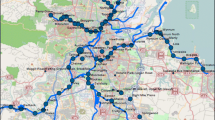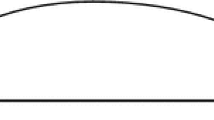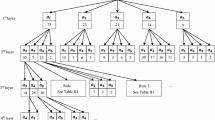Abstract
Choice modeling is important in transportation planning, marketing and engineering design, as it can quantify the influence of product attributes and customer demographics on customers’ choice behaviors. Consumer studies suggest that customers’ choice-making process often consists of two different stages: customers first consider subsets of available products on the market, and then make the final choice from the subsets. As existing preference modeling is mostly focused on the choice stage, there is a need to develop methods for understanding customer preferences at both stages, and investigate how customer preferences change from “consideration” to “choice”, and whether such changes will be consistent over time. In this paper, we study customers’ consideration and purchase behaviors in China’s auto market using multi-year survey datasets. We demonstrate how descriptive network analysis and analytic network models (bipartite Exponential Random Graph Model (ERGM)) capture the change of customers’ preferences from the consideration stage to the choice stage in multiple consecutive years. Our results show that factors such as fuel consumption per unit power, car make origin, and place of production influence customers’ considerations and final purchase decisions in different ways, and this difference between consideration and purchase is consistent over time. The main contribution of this study is that we validate the two-stage network-based modeling approach and its utility in preference elicitation using multiple-year dataset, which sheds lights on understanding the trend of customers’ consideration and choice behaviors across years. Our study also contributes to a refined interpretation of the ERGM results with categorization of continuous variables into ranges, which shows that customer choice decisions may be more qualitatively influenced by product attributes rather than quantitatively. Our approach is generic and thus can be applied to solving broader choice modeling problems, such as the transportation mode selection and the adoption of clean technology (e.g., electric vehicles).


Similar content being viewed by others
Notes
“Edges” are defined as the number of links in the network, and its coefficient can be considered as the intercept of a regression. However, here the intercept by itself does not necessarily provide meaningful interpretation. To explain the intercept, one needs to set all input categorical variables as baselines and all continuous variables as zeros, which is not physically meaningful in our case. Network researchers commonly interpret the meaning of “Edges” only when it is the single input variable in an ERGM.
We studied an additional dataset with 5000 non-overlapped random samples, and found the new results are quite similar to what we reported here, and the same conclusions hold.
References
Amador FJ, González RM, de Dios OJ (2008) On confounding preference heterogeneity and income effect in discrete choice models. Networks Spat Econ 8:97–108
Ben-Akiva ME, Lerman SR (1985) Discrete choice analysis: theory and application to travel demand. MIT press
Bi Y, Li S, Wagner D, Reid T (2017) The impact of vehicle silhouettes on perceptions of car environmental friendliness and safety in 2009 and 2016: a comparative study. Des Sci 3
Bi Y, Xie J, Sha Z, et al (2018) Modeling Spatiotemporal Heterogeneity of Customer Preferences in Engineering Design. In: ASME 2018 International design engineering technical conferences & computers and information in engineering conference. Quebec City, 2018
Broekel T, Bednarz M (2018) Disentangling link formation and dissolution in spatial networks: an application of a two-mode STERGM to a project-based R&D network in the German biotechnology industry. Networks Spat Econ 18:677–704
Chen W, Hoyle C, Wassenaar HJ (2013) Decision-based design: integrating consumer preferences into engineering design. Springer Science and Business Media
Ding R, Ujang N, Bin HH et al (2019) Application of complex networks theory in urban traffic network researches. Networks Spat Econ 19:1281–1317
Dubois B, Laurent G, Czellar S, others (2001) Consumer rapport to luxury: analyzing complex and ambivalent attitudes. Groupe HEC Jouy-en-Josas
Dubois B, Paternault C (1995) Understanding the world of international luxury brands: the" dream formula."(special issue: research input into the creative process). J Advert Res 35:69–77
Fu JS, Sha Z, Huang Y et al (2017) Modeling Customer Choice Preferences in Engineering Design using Bipartite Network Analysis. In: Proceedings of the ASME 2017 International design engineering technical conferences and computers and information in engineering conference, vol 2017, Cleveland
Fujii S, Kitamura R (2004) Drivers’ mental representation of travel time and departure time choice in uncertain traffic network conditions. Networks Spat Econ 4:243–256
Gorsuch RL (1983) Factor analysis. Lawrence Erlbaum Associates, Hillsdale
Green PE (1970) Multidimensional scaling and related techniques in marketing analysis. Allyn and Bacon
Green PE, Srinivasan V (1990) Conjoint analysis in marketing: new developments with implications for research and practice. J Mark 54:3–19
Hauser JR, Ding M, Gaskin SP (2009) Non-compensatory (and compensatory) models of consideration-set decisions. In: 2009 Sawtooth software conference proceedings, sequin WA, vol 2009, Delray Beach
Hauser JR, Toubia O, Evgeniou T, Befurt R, Dzyabura D (2010) Disjunctions of conjunctions, cognitive simplicity, and consideration sets. J Mark Res 47:485–496
Hauser JR, Wernerfelt B (1990) An evaluation cost model of consideration sets. J Consum Res 16:393–408
He L, Chen W, Hoyle C, Yannou B (2012) Choice modeling for usage context-based design. J Mech Des 134:31007
He L, Wang M, Chen W, Conzelmann G (2014) Incorporating social impact on new product adoption in choice modeling: a case study in green vehicles. Transp Res Part D Transp Environ 32:421–434
Hoyle C, Chen W, Wang N, Koppelman FS (2010) Integrated Bayesian hierarchical choice modeling to capture heterogeneous consumer preferences in engineering design. J Mech Des 132:121010. https://doi.org/10.1115/1.4002972
Hunter DR, Handcock MS, Butts CT et al (2008) Ergm: a package to fit, simulate and diagnose exponential-family models for networks. J Stat Softw 24:nihpa54860
Johnson R (2011) Multiple discriminant analysis: marketing research applications. Marketing Classics Press
Kamakura WA, Russell GJ (1989) A probabilistic choice model for market segmentation and elasticity structure. J Mark Res 26:379–390
Lam WHK, Huang H-J (2003) Combined activity/travel choice models: time-dependent and dynamic versions. Networks Spat Econ 3:323–347
Liu Q, Arora N (2011) Efficient choice designs for a consider-then-choose model. Mark Sci 30:321–338
Manski CF (1977) The structure of random utility models. Theory Decis 8:229–254
Min S-H, Han I (2005) Detection of the customer time-variant pattern for improving recommender systems. Expert Syst Appl 28:189–199
Morris M, Handcock MS, Hunter DR (2008) Specification of exponential-family random graph models: terms and computational aspects. J Stat Softw 24:1548–7660
Nielsen OA, Daly A, Frederiksen RD (2002) A stochastic route choice model for car travellers in the Copenhagen region. Networks Spat Econ 2:327–346
Pelleg D, Moore AW, others (2000) X-means: extending k-means with efficient estimation of the number of clusters. In: Icml, pp 727–734
Rasouli S, Timmermans H (2016) Influence of social networks on latent choice of electric cars: a mixed logit specification using experimental design data. Networks Spat Econ 16:99–130
Robins G, Pattison P, Kalish Y, Lusher D (2007) An introduction to exponential random graph (p*) models for social networks. Soc Networks 29:173–191
Ross Morrow W, Long M, MacDonald EF et al (2014) Market-system design optimization with consider-then-choose models. J Mech Des 136:31003. https://doi.org/10.1115/1.4026094
Saberi M, Rashidi TH, Ghasri M, Ewe K (2018) A complex network methodology for travel demand model evaluation and validation. Networks Spat Econ 18:1051–1073
Sha Z, Huang Y, Fu S et al (2018) A Network-Based Approach to Modeling and Predicting Product Co-Consideration Relations. Complexity 2018
Sha Z, Saeger V, Wang M, Fu Y, Chen W (2017) Analyzing customer preference to product optional features in supporting product configuration. SAE Int J Mater Manuf 10:320–332
Shao W (2007) Consumer decision-making: an empirical exploration of multi-phased decision processes. Griffith University
Shocker AD, Ben-Akiva M, Boccara B, Nedungadi P (1991) Consideration set influences on consumer decision-making and choice: issues, models, and suggestions. Mark Lett 2:181–197
Stylidis K, Burnap A, Rossi M et al (2016) A preliminary study of trends in perceived quality design attributes in the automotive luxury market segment. In: DS 84: proceedings of the DESIGN 2016 14th international design conference, pp 2189–2196
Suryadi D, Kim HM (2019) A data-driven methodology to construct customer choice sets using online data and customer reviews. J Mech Des:1–19
Tanaka M, Ida T, Murakami K, Friedman L (2014) Consumers’ willingness to pay for alternative fuel vehicles: a comparative discrete choice analysis between the US and Japan. Transp Res Part A Policy Pract 70:194–209
Tovares N, Cagan J, Boatwright P (2013) Capturing consumer preference through experiential conjoint analysis. ASME Pap No DETC2013–12549
Train K (1986) Qualitative choice analysis: theory, econometrics, and an application to automobile demand. MIT press
Train KE (2009) Discrete choice methods with simulation. Cambridge university press
Turrentine TS, Kurani KS (2007) Car buyers and fuel economy? Energy Policy 35:1213–1223
Wang M, Chen W, Fu Y, Yang Y (2015a) Analyzing and predicting heterogeneous customer preferences in China’s auto market using choice modeling and network analysis. SAE Int J Mater Manuf 8:668–677
Wang M, Chen W, Huang Y, Contractor NS, Fu Y (2016a) Modeling customer preferences using multidimensional network analysis in engineering design. Des Sci 2
Wang M, Chen W, Huang Y et al (2015b) A Multidimensional Network Approach for Modeling Customer-Product Relations in Engineering Design. In: ASME 2015 International Design Engineering Technical Conferences & Computers and information in engineering conference, vol 2015, Boston
Wang M, Huang Y, Contractor N et al (2016b) A Network Approach for Understanding and Analyzing Product Co-Consideration Relations in Engineering Design. In: Proceedings of the DESIGN 2016 14th international design conference, Cavtat, Dubrovnik, Croatia, vol 2016
Wang M, Sha Z, Huang Y et al (2016c) Forecasting technological impacts on customers’ co-consideration behaviors: a data-driven network analysis approach. In: ASME 2016 international design engineering technical conferences and computers and information in engineering conference, vol 2016, Charlotte, p V02AT03A040
Wang M, Sha Z, Huang Y et al (2018) Predicting Products’ Co-Considerations and Market Competitions for Technology-Driven Product Design: A Network-Based Approach. Des Sci J 4
Wang P (2013) Exponential random graph model extensions: models for multiple networks and bipartite networks, Exponential random graph Model Soc networks Theory, methods, Appl, pp 115–129
Wang P, Pattison P, Robins G (2013a) Exponential random graph model specifications for bipartite networks’ dependence hierarchy. Soc Networks 35:211–222
Wang P, Robins G, Pattison P, Lazega E (2013b) Exponential random graph models for multilevel networks. Soc Networks 35:96–115
Wasi N, Keane MP, others (2012) Estimation of Discrete Choice Models with Many Alternatives Using Random Subsets of the Full Choice Set: With an Application to Demand for Frozen Pizza
Wright P (1975) Consumer choice strategies: simplifying vs. optimizing. J Mark Res:60–67
Zhao M, Derudder B, Zhang P, Zhong P (2020) An expanded bipartite network projection algorithm for measuring cities’ connections in service firm networks. Networks Spat Econ 20:479–498
Acknowledgments
The authors gratefully acknowledge the financial support from NSF-CMMI-1436658 and the Ford-Northwestern Alliance Project.
Author information
Authors and Affiliations
Corresponding author
Additional information
Publisher’s note
Springer Nature remains neutral with regard to jurisdictional claims in published maps and institutional affiliations.
Rights and permissions
About this article
Cite this article
Bi, Y., Qiu, Y., Sha, Z. et al. Modeling Multi-Year Customers’ Considerations and Choices in China’s Auto Market Using Two-Stage Bipartite Network Analysis. Netw Spat Econ 21, 365–385 (2021). https://doi.org/10.1007/s11067-021-09526-9
Accepted:
Published:
Issue Date:
DOI: https://doi.org/10.1007/s11067-021-09526-9




